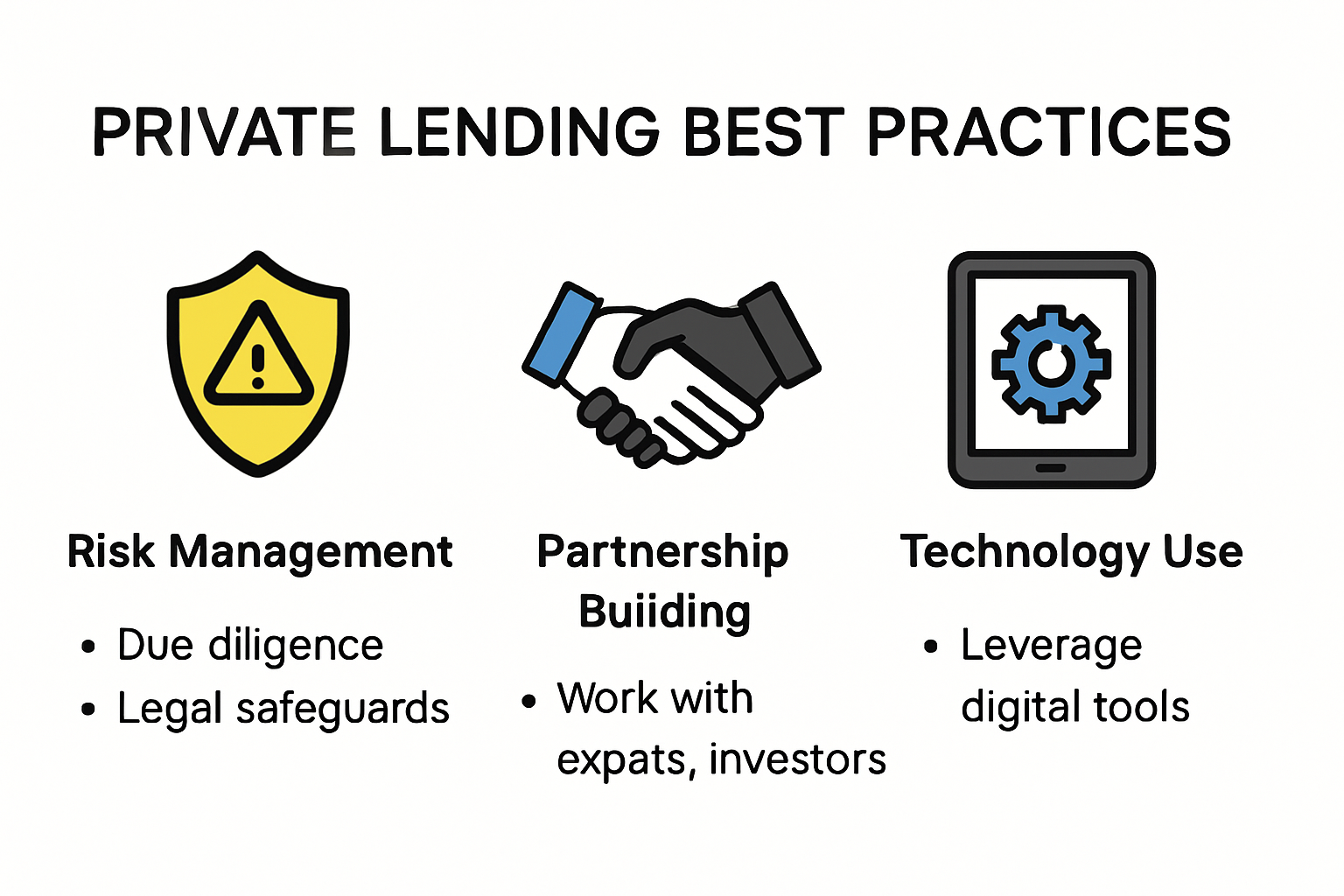
Private lending has become a magnet for expats and investors chasing high returns, and some deals in Costa Rica now offer annual yields as high as 18 percent. That is headline-grabbing enough. But here is what most overlook. The real deciding factor is not just the lofty numbers. Success comes down to how well you can guard against risk, decode local legal rules, and use technology to your edge. The strategies that separate winners from everyone else are not what you might expect.
Table of Contents
- Understanding Risks And Rewards In Private Lending
- Key Strategies For Secure Private Lending Deals
- Legal And Financial Considerations In Costa Rica
- Building Successful Partnerships For Long-Term Growth
Quick Summary
| Takeaway | Explanation |
|---|---|
| Understand Market Risks | Assess borrower creditworthiness, market conditions, and legal compliance to effectively manage risks associated with private lending. |
| Conduct Comprehensive Due Diligence | Implement multi-layered verification processes to create detailed risk profiles and scrutinize every aspect of potential lending opportunities. |
| Secure Legal Protections | Develop robust loan agreements that address potential defaults and ensure first-lien status and comprehensive collateral requirements for financial security. |
| Leverage Technology for Insights | Utilize advanced data analytics platforms for real-time market insights and continuous monitoring of borrower performance to support informed investment decisions. |
| Build Sustainable Partnerships | Focus on trust and strategic collaboration with borrowers, utilizing local expertise and cultural understanding to create long-term mutually beneficial relationships. |

Understanding Risks and Rewards in Private Lending
Private lending represents a complex financial landscape where strategic opportunities intersect with significant potential risks. Investors and expats must develop a nuanced understanding of the intricate dynamics that define this alternative investment strategy.
The Financial Spectrum of Private Lending
Private lending extends beyond traditional banking frameworks, offering a unique investment avenue with potentially higher returns and more flexible lending criteria. Investors enter this market with the expectation of earning returns significantly higher than conventional investment vehicles. Typical yields range between 12% to 18% annually, which attracts sophisticated investors seeking robust passive income streams.
The rewards are compelling. Unlike traditional bank investments, private lending allows direct engagement with real estate backed loans. Investors can secure their investments through first-lien positions on properties, providing a substantial layer of protection. explore our comprehensive lending insights to understand the nuanced strategies that can mitigate potential risks.
Critical Risk Assessment Strategies
Risk management becomes paramount in private lending. Sophisticated investors recognize that higher returns correlate directly with increased risk exposure. Key risk factors include:
-
Borrower Creditworthiness: Thorough vetting processes are non-negotiable. Detailed background checks, income verification, and comprehensive property assessments form the foundation of responsible lending.
-
Market Volatility: Real estate markets fluctuate. Investors must conduct rigorous market analysis, understanding local economic trends, property values, and potential depreciation scenarios.
-
Legal Compliance: Regulatory environments constantly evolve. Staying informed about current lending regulations, tax implications, and potential legal constraints is crucial for protecting investment portfolios.
Successful private lenders develop robust due diligence frameworks. They evaluate not just the potential returns but also the comprehensive risk profile of each potential lending opportunity. This means examining borrower history, property valuation, market conditions, and potential exit strategies.
Technological advancements and data analytics now provide investors with sophisticated tools to assess and monitor lending risks. Advanced screening algorithms, real-time market tracking, and comprehensive financial modeling enable more precise risk evaluation than ever before.
The most successful private lending strategies integrate multiple risk mitigation techniques. This includes diversifying lending portfolios, maintaining conservative loan-to-value ratios, and establishing clear legal protections through meticulously crafted loan agreements.
For expats and international investors, understanding local market dynamics becomes even more critical. Each region presents unique economic conditions, legal frameworks, and investment landscapes. Specialized knowledge of local real estate markets, economic stability, and regulatory environments can significantly reduce potential investment risks.
While private lending offers substantial opportunities, it demands a strategic, informed approach. Investors must balance their appetite for higher returns with comprehensive risk management techniques. Those who invest time in understanding market dynamics, developing robust due diligence processes, and maintaining flexible investment strategies will be best positioned to succeed in this dynamic financial ecosystem.
To help clarify the key risks in private lending and common mitigation strategies outlined above, here is a summary table:
| Key Risk Factor | Description | Common Mitigation Strategy |
|---|---|---|
| Borrower Creditworthiness | Potential for borrower default or unreliable payment behavior | Detailed background checks, income verification |
| Market Volatility | Property value fluctuations and changing economic conditions | Rigorous market analysis, conservative LTV ratios |
| Legal Compliance | Changing regulations, tax, or legal issues impacting lending | Stay informed, use legal professionals |
| Collateral Valuation | Inaccurate property assessments or hidden encumbrances | Comprehensive property valuation, due diligence |
| Geographic Risk | Unfamiliarity with local market/regulatory landscape | Partner with local experts, market research |
Key Strategies for Secure Private Lending Deals
Secure private lending demands a strategic approach that combines meticulous research, robust risk management, and sophisticated financial planning. Investors and expats must develop comprehensive frameworks to protect their investments while maximizing potential returns.
Advanced Due Diligence Techniques
Successful private lending begins with an ironclad due diligence process. Investors must go beyond surface-level assessments, implementing multi-layered verification strategies that scrutinize every aspect of potential lending opportunities. This means conducting exhaustive background checks on borrowers, performing deep property valuations, and analyzing comprehensive financial histories.
The most effective due diligence involves creating a detailed risk profile for each potential lending opportunity. This includes examining the borrower’s credit history, income stability, existing debt obligations, and overall financial health. Property assessments must extend beyond simple market value, investigating potential legal encumbrances, environmental risks, and long-term appreciation potential.
Technological tools now enable more sophisticated risk assessment. Advanced data analytics platforms provide real-time insights into market trends, borrower creditworthiness, and potential investment vulnerabilities. explore advanced lending opportunities for 2025 to understand how cutting-edge technologies are transforming private lending strategies.

Legal and Financial Protection Frameworks
Legal protection stands as the cornerstone of secure private lending. Investors must develop robust contractual mechanisms that provide comprehensive safeguards for their investments. This involves creating meticulously crafted loan agreements that address potential scenarios, including default, market fluctuations, and unexpected economic challenges.
Key protection strategies include:
-
First-Lien Positioning: Securing first-lien status on properties provides the highest level of legal protection. This ensures priority claim on collateral in case of borrower default.
-
Comprehensive Collateral Requirements: Implementing strict collateral requirements that exceed the loan value creates an additional layer of financial security.
-
Flexible Repayment Mechanisms: Designing loan structures with multiple repayment options and clear consequences for non-compliance.
Sophisticated investors recognize the importance of diversification as a risk mitigation strategy. This means spreading investments across multiple properties, borrowers, and geographic regions. No single loan should represent a disproportionate percentage of an investor’s total portfolio.
Local legal expertise becomes crucial for expats and international investors. Understanding the nuanced legal landscapes of specific regions can prevent potential complications. This might involve partnering with local legal professionals who specialize in real estate and lending regulations.
Financial protection extends beyond legal documentation. Investors must maintain comprehensive insurance coverage, implement robust monitoring systems, and develop clear exit strategies for potential worst-case scenarios.
The most successful private lending strategies combine technological insights, legal expertise, and financial sophistication. Investors who approach private lending as a strategic, data-driven investment will be best positioned to navigate the complex landscape of alternative lending.
Ultimately, secure private lending is about balancing potential returns with comprehensive risk management. It requires continuous learning, adaptability, and a commitment to developing increasingly sophisticated investment approaches. Those who invest time in understanding market dynamics and building robust protection mechanisms will find private lending an increasingly attractive investment strategy.
Below is a table summarizing common legal and financial protection strategies mentioned for securing private lending deals:
| Protection Strategy | Purpose | Example Action |
|---|---|---|
| First-Lien Positioning | Secure priority claim on collateral | Record lien at property registry |
| Comprehensive Collateral | Reduce lender exposure to borrower default | Accept collateral exceeding loan |
| Flexible Repayment Mechanisms | Adapt to borrower circumstances, reduce risk | Structure varied payment options |
| Diversification | Spread risk across multiple loans/areas | Lend to different borrowers/regions |
| Use of Local Legal Expertise | Navigate regional legal requirements | Employ local attorney/notary |
| Insurance Coverage | Protect asset against loss or damage | Obtain property/investment insurance |
Legal and Financial Considerations in Costa Rica
Navigating the private lending landscape in Costa Rica requires a sophisticated understanding of the unique legal and financial frameworks that govern investment opportunities. Expats and international investors must develop comprehensive strategies that align with local regulations while protecting their financial interests.
Regulatory Landscape and Compliance Framework
Costa Rica’s financial ecosystem presents a complex regulatory environment that demands meticulous attention to legal details. The financial regulatory bodies SUGEF and CONASSIF establish stringent guidelines that govern private lending practices. These regulations create a structured approach to financial transactions, ensuring transparency and investor protection.
Foreign investors must recognize that Costa Rican financial regulations differ significantly from those in their home countries. Documentation requirements are extensive. All financial agreements require precise translation into Spanish, with official notarization serving as a critical step in establishing legal validity. Investors should anticipate comprehensive documentation processes that include detailed income verification, comprehensive background checks, and thorough property assessments.
discover comprehensive lending insights for investors to understand the nuanced legal requirements that shape successful private lending strategies in Costa Rica.
Financial Structuring and Risk Mitigation
Successful private lending in Costa Rica demands sophisticated financial structuring. Typical loan arrangements differ markedly from traditional banking models. Investors can expect interest rates ranging between 10% to 15%, with loan terms typically spanning one to three years. Down payment requirements are substantially higher than conventional lending markets, often ranging from 30% to 50% of the total property value.
Key financial considerations include:
-
Property Valuation: Comprehensive property assessments that go beyond market value, examining legal status, potential encumbrances, and long-term appreciation potential.
-
Currency Considerations: Understanding exchange rate risks and potential financial regulations affecting international fund transfers.
-
Tax Implications: Navigating the complex tax landscape for foreign investors, including potential withholding requirements and reporting obligations.
Local legal expertise becomes invaluable. Investors should consider partnering with Costa Rican attorneys specializing in real estate and financial regulations. These professionals can provide critical insights into local market dynamics, potential legal complications, and strategic investment approaches.
The licensing and operational requirements for financial institutions in Costa Rica are rigorous. Potential lenders must navigate a complex approval process that can extend up to 12 months, requiring significant capital deposits with the Central Bank of Costa Rica. This regulatory approach ensures a stable and transparent financial environment.
Expats and international investors must develop a holistic approach to private lending. This means understanding not just the financial mechanisms but the broader cultural and legal context of investment in Costa Rica. Successful strategies integrate local market knowledge, robust legal protections, and flexible financial planning.
Technology now plays a crucial role in simplifying these complex processes. Advanced digital platforms provide real-time insights into market trends, regulatory changes, and investment opportunities. Investors who leverage these technological tools can navigate the Costa Rican private lending landscape with greater confidence and precision.
Ultimately, success in Costa Rican private lending requires more than financial resources. It demands patience, cultural understanding, and a commitment to developing comprehensive, locally informed investment strategies. Those who invest time in understanding the intricate legal and financial landscape will find remarkable opportunities in this dynamic market.
Building Successful Partnerships for Long-Term Growth
Successful private lending transcends mere financial transactions. It represents a strategic approach to building sustainable, mutually beneficial relationships that drive long-term growth and create value for both investors and borrowers in the dynamic Costa Rican real estate market.
Foundations of Strategic Partnership Development
Effective partnerships in private lending require a holistic approach that goes beyond traditional transactional models. Investors must develop comprehensive relationship-building strategies that prioritize trust, transparency, and mutual understanding. This means looking beyond immediate financial returns and focusing on creating sustainable, long-term investment ecosystems.
The most successful private lending partnerships are built on a foundation of deep market knowledge and shared strategic objectives. Investors need to develop a nuanced understanding of each borrower’s unique financial landscape, long-term goals, and potential growth trajectories. This approach transforms private lending from a simple financial exchange into a collaborative growth partnership.
learn about our partnership approach to understand how strategic relationships drive investment success in Costa Rica.
Leveraging Technology and Network Intelligence
Modern private lending partnerships rely heavily on advanced technological tools and sophisticated network intelligence. Sophisticated investors utilize comprehensive data analytics platforms that provide real-time insights into borrower performance, market trends, and potential growth opportunities. These technologies enable more precise risk assessment and more strategic partnership development.
Key technological strategies include:
-
Advanced Screening Mechanisms: Implementing AI-driven credit assessment tools that provide deeper insights into borrower potential.
-
Continuous Performance Monitoring: Developing real-time tracking systems that allow for proactive partnership management.
-
Network Intelligence Platforms: Creating comprehensive databases that connect investors with high-potential borrowers and opportunities.
Successful partnerships require a dynamic approach to relationship management. This means developing flexible financing structures that can adapt to changing market conditions and individual borrower needs. Investors must be prepared to offer creative solutions that go beyond traditional lending models.
Local expertise becomes a critical component of effective partnership development. Investors who invest time in understanding the local cultural and economic landscape can create more meaningful and sustainable relationships. This involves building strong networks within local real estate communities, developing relationships with local legal and financial professionals, and maintaining a deep understanding of regional market dynamics.
The most sophisticated private lending partnerships integrate multiple layers of value creation. This goes beyond financial returns to include strategic guidance, network connections, and long-term growth support. Successful investors position themselves as true partners, offering expertise, resources, and strategic insights that extend far beyond simple capital provision.
Cultural intelligence plays a crucial role in building successful international partnerships. Investors must develop a nuanced understanding of local business practices, communication styles, and relationship-building approaches. This means investing time in developing genuine connections and demonstrating a commitment to mutual success.
Ultimately, long-term growth in private lending is about creating ecosystems of mutual benefit. The most successful investors approach each partnership as a collaborative journey, focusing on creating sustainable value that extends beyond immediate financial returns. Those who can develop sophisticated, technology-enabled, and relationship-driven investment approaches will find remarkable opportunities in the evolving private lending landscape.
Frequently Asked Questions
What is private lending and how does it work?
Private lending involves individuals or organizations providing funds directly to borrowers, often secured by property. The process typically bypasses traditional banking institutions and offers potentially higher returns for investors.
What are the key risks associated with private lending for expats?
Key risks include borrower creditworthiness, market volatility, and legal compliance. It’s crucial for expats to conduct thorough due diligence and stay informed about the local regulatory environment.
How can I assess borrower creditworthiness in private lending?
Assessing borrower creditworthiness involves conducting detailed background checks, income verification, and property assessments. Creating a comprehensive risk profile helps in evaluating the borrower’s ability to repay the loan.
What legal protections should I consider when engaging in private lending in Costa Rica?
When lending in Costa Rica, consider securing first-lien status on the property, implementing comprehensive collateral requirements, and developing well-crafted loan agreements that address potential defaults and market changes.
Ready to Turn Private Lending Insights Into Real Results?
You just learned the best ways to manage risk, protect your investments, and spot real estate-backed opportunities as an expat or international investor in Costa Rica. But knowing what to look for is only the first step. Many readers struggle with finding reliable local partners, dealing with complex legal paperwork, and securing high-yield, first-lien loans that are fully vetted and transparent.

Take action now and put your knowledge to work with CostaRicaLoanExperts.net. Explore our trusted lending platform where expats, property owners, and investors come together for fast approvals and legally secure investments. Use our user-friendly loan request and investor tools to gain confidence and start building your Costa Rican portfolio today.
There’s never been a more important time to apply proven best practices with a partner who puts transparency and security first—so connect with us now and start moving from strategy to success.
Recommended Articles
- private lending opportunities 2025 – costaricaloanexperts.net
- Private Lending Opportunities 2025: Smart Strategies for Expats & Investors – costaricaloanexperts.net
- private lending explained – costaricaloanexperts.net
- Private Lending Explained: Guide for Costa Rica Investors 2025 – costaricaloanexperts.net
- Real Estate Backed Investments in 2025: Safe Passive Income for Expats & Investors – costaricaloanexperts.net
- BLOG – costaricaloanexperts.net
